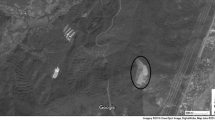Abstract
A one-dimensional mathematical model based on convection–dispersion equation in unsaturated porous media is presented to compute inorganic total solid concentration in the soil column under the Shiraz landfill. In addition, a dynamic mathematical model is formulated to simulate concentrations of ions such as Ca2+, Mg2+, Fe2+, K+, Na+, Cl−, SO4 2− and HCO3 − as well as PH and EC in soil profile under the Shiraz landfill. Leachw model was applied to simulate water flow, water content and hydraulic conductivity in soil depth. The model was calibrated and verified by using different sets of data collected from several segments of soil depth in the study area. The numerical solution obtained using finite element method. The simulated values for the parameters were compared with measured values as well as analytical solution. The simulated results are in good agreement with measured values. This model could be applied to field scale problems for the landfill management.















Similar content being viewed by others
Abbreviations
- θ :
-
Water content [L 3/L 3]
- q :
-
Darcy velocity [L/T]
- z :
-
Elevation, computed from surface to bottom [L]
- K(θ):
-
Hydraulic conductivity [L/T]
- ψ :
-
Suction head [L]
- t :
-
Time [T]
- c :
-
Specific moisture capacity equal to \( \frac{{{\text{d}}\theta }}{{{\text{d}}\psi }} \), θ − ψ and K − θ
- ψ s :
-
Suction head near saturation [L]
- K sat :
-
Saturation hydraulic conductivity [L/T]
- b :
-
An experimental constant
- θ s :
-
Water content [L 3/L 3]
- C :
-
Fluid phase concentration [M/L 3]
- D h :
-
Hydrodynamic longitudinal dispersion coefficient [L 2/T]
- λ:
-
Dispersivity [L]
- K′:
-
Rate coefficient [1/T]
- S :
-
Local mass per bulk volume of refuse available for transfer at time t [M/T 3]
- S 0 :
-
Local mass per bulk volume of refuse available for transfer at time t = 0 [M/T 3]
- C st :
-
Maximum contaminant concentration in the liquid phase [M/T 3]
- N1 and N2:
-
Shape functions in each node
- ZA and ZB:
-
Coordinates of start and end node of a typical element
- W :
-
Trial function
- C a :
-
The concentration of TS in unit mass of soil
- ρ d :
-
Dry soil density
- D :
-
Mechanical dispersivity
- D M :
-
Molecular dispersivity
- V :
-
Average flow velocity
- R :
-
Delay coefficient
- K ads :
-
Adsorption coefficient and n is soil porosity
References
Alemi MH, Goldhamer DA, Nielsen DR (1991) Modeling selenium transport in steady state, unsaturated soil columns. J Environ Quality 20:89–95
Aroa T, Linde N, Revil A (2007) Non-intrusive characterization of the redox potential of landfill leachate plumes from self-potential data. J Contaminant Hydrol 92(3–4):274–292
Baumann T, Fruhstorfer P, Klein T, Niessner R (2006) Colloid and heavy metal transport at landfill sites in direct contact with groundwater. Aterresearch 40:2776–2786
Birbech AE et al (1980) Evaluation of landfill beds as anaerobic treatment systems for landfill leachate. In: Proceeding of technical association of the pulp and paper industry, environmental conference, Denver, COLCO, pp 8–11
Demetracopoulos AC, Sehavek L, Erdogan H (1986) Modeling Leachate Production from Municipal Landfills. Journal of Environmental Eng 112(5)
Hentrich RL et al (1979) Influence of Msw processing on gas and leachate production, municipal solid waste: land disposal. In: Proceeding of the fifth annual research symposium, EPA-600/9-79-023 A, Aug 1979
Huston JI, Wagenet RJ (1989) Leaching estimation and chemistry model, a process based model of water and solute movement, transformations, plant uptake and chemical reaction in the unsaturated zone. Department of Agronomy, Cornel University, Ithaca. New York. Version 2, p 148
Khire MV, Mukherjee M (2007) Leachate injection using vertical wells in bioreactor landfills. Waste Management 27(9):1233–1247
Leckie JO, Halvadakis C, Pacey JG (1979) Landfill management with moisture control. J Environ Eng Div ASCE 105(2):337–355
McCreanor PT, Reinhart D (2000) Mathematical modeling of leachate routing in a leachate recirculating landfill. Water Res 34:1285–1295
Mirbagheri SA, Tanji KK, Rajaee T (2008) Selenium transport and transformation modeling in soil columns and ground water contamination prediction. J Hydrol Process. doi:10.1002/hyp.6842
Pohland FG (1975) Sanitary landfill stabilization with leachate recycle and residual treatment, Environmental Protection Agency, EPA-600/2-75-043
Qasim SR, Burchinal JC (1970) Leaching of pollutants from refuse beds. Journal of sanitary Engineering division ASCE 96:12–20
Rovers FA, Farquhar Gj (1973) Infiltration and landfill behavior, ASCE. Journal of Environmental Engineering 99(5):671–690
Straub WA (1980) Department and application of models of sanitary landfill leaching and landfill stabilization, Thesis presented to Thayer School of Engineering, Danmouth College at Hanover, NH
Straub WA, Lynch DR (1982) Models of landfill leaching: moisture flow and inorganic strength, ASCE. Journal of Environmental Engineering 108(2):231–250
van Breukelena BM, Griffioenb J (2004) Biogeochemical processes at the fringe of a landfill leachate pollution plume: potential for dissolved organic carbon, Fe(II), Mn(II), NH4, and CH4 oxidation. Journal of Contaminant Hydrology 73:181–205
Walsh HJ, Kinman RN (1979) Leachate and gas production under controlled moisture conditions, municipal solid waste, land disposal. In: Proceeding of fifth annual research symposium, EPA-600, 9-79-023a
Wigh RJ (1979) Boone County field site interim report, Environmental Protection Agency, EPA-600/2-79-058
Author information
Authors and Affiliations
Corresponding author
Rights and permissions
About this article
Cite this article
Mirbagheri, S.A., Hashemi Monfared, S.A. & Kazemi, H.R. Simulation modelling of pollutant transport from leachate in Shiraz landfill. Environ Earth Sci 59, 287–296 (2009). https://doi.org/10.1007/s12665-009-0026-4
Received:
Accepted:
Published:
Issue Date:
DOI: https://doi.org/10.1007/s12665-009-0026-4




